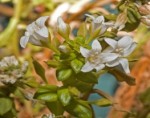Latin: Lysimachia mauritiana
Description: A low crawling herbaceous groundcover with light green, succulent leaves and white flower clusters. The leaves emerge radially out from the center giving it a nice shape, while the flower clusters protrude up above the rest of the plant, allowing them to be shown off. Once pollinated the flowers develop into small light brown seed capsules, each containing numerous, tiny, dark brown seeds
Distribution: Seldom seen in the wild, this is the only native Lysimachia today that is indigenous and occurs at low elevations. All other native Lysimachia are considered endemic and occur in higher, wetter elevations. This plant is naturally found on coastal cliffs or rocky shorelines on the islands of Ni’ihau, Kauai, Molokai, Maui and Hawaii, pretty much everywhere else but O’ahu. As stated earlier this plant is indigenous therefore it is native to other places including other Pacific islands, Japan, Korea, India, Taiwan and China.
Landscape use and care: This plant looks great planted around large landscape stones or when used as a bedding plant. It doesn’t spread far, at about 1 square foot, so space accordingly. Few pests are known to bother this plant, but if some sort of infestation does occur, proper application of store-bought pesticides will not harm the plant. This plant is naturally short-lived so don’t be concerned if it slowly dies after one to two years, its natural. Ideally, the plant would have set a bunch of seeds and your next round of plants should germinate shortly after that. Other than that it is still a very attractive plant and for a limited time it is available at the Home Depot in Town and Pearl City for about $6.
Cultural uses: Other than using the flower clusters in head lei, there are no other known uses for this plant in Hawaiian culture
Additional Information: Although not found on O’ahu today its hard to say that this plant was never found here. This plant occurs naturally where many migratory birds forage so it could easily be transported from island to island. Who knows, maybe someday this plant will naturally occur here again in the future.
Costal Lysimachia







